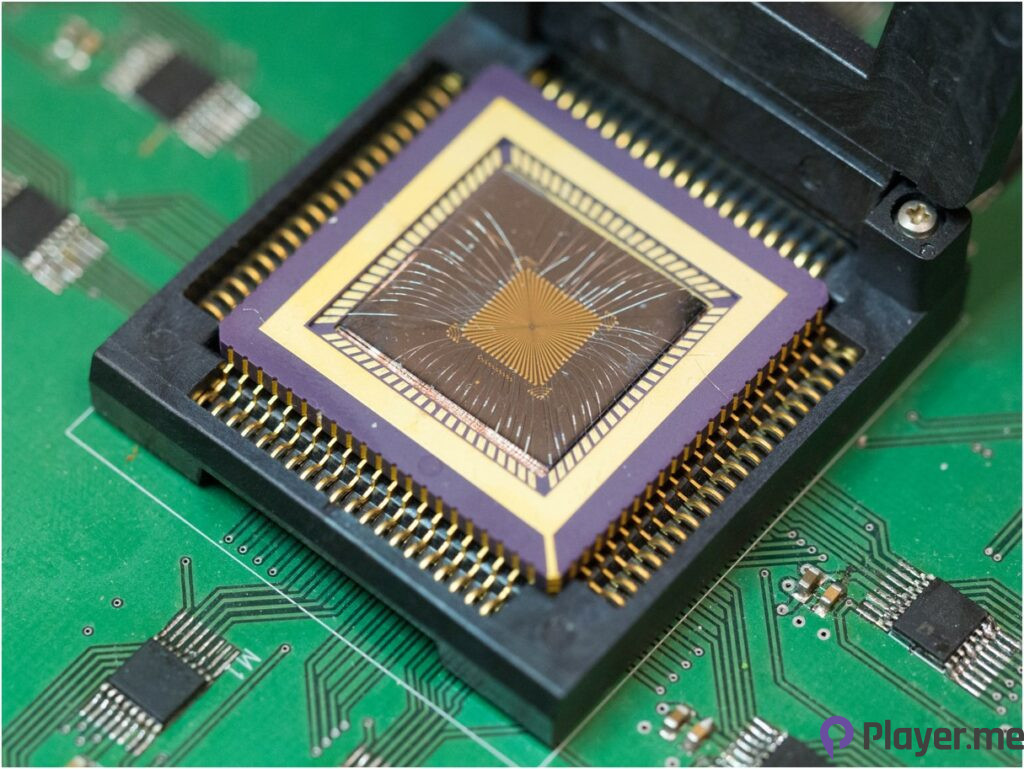In a seeming breakthrough for AI, Chinese scientists at Tsinghua University have successfully developed the world’s first fully system-integrated memristor computing-in-memory chip that supports efficient on-chip learning, which is also energy efficient. Furthermore, the researchers claim that the memristor chip could enable the development of AI with more human-like learning capabilities, which could have implications for the operations of smart devices and self-driving cars.
Despite the United States imposing export controls and sanctions restricting the supply of advanced chips and chip-making equipment to the nation, it did not stop the research team from spending 11 years of their life to complete the job from scratch. Today, our AI aficionado will dissect the new memristor chip and how it will affect the future of AI.
What Is Memristor?
The memristor is the fourth fundamental component of an electrical circuit after resistors, capacitors, and inductors. It can remember the transmitted charge after the power is turned off and serves as a new type of nanoelectronic adapter. In simpler terms, a memristor is an electrical component that regulates the flow of an electrical current.

Therefore, the memristor has the ability to learn through improving or maintaining pre-existing knowledge before learning something new. Moreover, it differs from transfer learning, which solely focuses on transferring to a new data set and even sacrifices the accuracy of previous data.
Also Read: Is Google’s New and Upcoming Gemini AI a Worthy Contender to OpenAI’s GPT-4?
How Does Memristor Improve AI?
According to Yao Peng: “The chip integrates complete circuit modules to support autonomous learning, and it has successfully demonstrated various learning tasks, including motion control, image classification and speech recognition. The chip also showed high energy efficiency and high accuracy in versatile AI tasks during the experiments, which can effectively strengthen the learning adaptability of intelligent devices in practical application scenarios.”

Unsurprisingly, to train artificial neural networks to mimic how human neurons transmit data in the brain, conventional hardware requires a lot of power and time to move data between computing and memory units. However, the memristor can reduce the energy needed for a task by allowing learning to occur on-chip without an external memory source. For example, they compared the motion control of a car model better equipped to track laser light in dark environments.
Before implementing the memristor chip, the car model lost track of the light in brighter surroundings. However, once they implemented the chip, they discovered the car could find equally good lighting in both environments and has enhanced accuracy in bright environments while not decreasing its ability in dark environments.
The Future of Memristor in AI
With a successful experiment at a headstart, the researchers are more than eager to continue innovating the chip for AI use. According to their report paper, the researcher claimed: “The memristor-based neuro-inspired computing chip could facilitate the development of edge AI devices that could adapt to new scenes and users.”
Although the chip is still in the laboratory, many are excited about the prospects it could bring. In the words of Yury Suleymanov, an associate editor at Science: “Memristor-based computing technology has recently received considerable attention because of its potential to overcome the so-called ‘Von Neumann Bottleneck’ of conventional computing architecture.”
While the claims of a 75 times more energy-efficient chip than current machines designed for AI processing may seem laughable, China has always proved their mantle with innovations like its Huawei phones. Moreover, the researchers in charge are confident as they claimed: “The study is an important step towards future chips with high energy efficiency and extensive learning capabilities. Hopefully, it will accelerate the development of future smart edge devices.”
Also Read: Meta Connect 2023: CEO Mark Zuckerberg Reveals 5 New and Exclusive AI Features
Concluding Statement
Despite the promising news, it could take a while before the chip could make it out of the laboratory, as admitted by the researchers. However, as we know the stereotypical meme, everywhere you go, there is always an Asian better than you. Thus, we could expect China to release such a chip soon. How long will it take for China to mass produce the chips? Let us know on our Facebook, Instagram and Twitter pages.
Frequently Asked Questions
What Challenges Will China Face in Developing Memristor?
The most prominent challenge the researchers will face is engineering the chips for large-scale integration. However, with the recent tax reductions and funding support, we can expect the memristor to be the norm by 2035.
Is U.S. Chip Sanction Enough to Deter China?
According to the report by East Asia Forum, the students in Tsinghua claimed that they can easily bypass and circumvent EDA restrictions by using Cadence and Synopsys — two of the most popular EDA providers from the United States — through back gate channels or special licenses. After receiving the chips, they could easily send advanced chips they design to Taiwan for manufacturing.
What Cutting-Edge Technology Has China Unveiled This Year?
The most impressive cutting-edge technology China has revealed is its Huawei Mate 60 Pro. While the phone may not compete with Apple products, the fact that China could unveil a phone with a sanction shows its resilience in pursuing new tech. For more information about Huawei’s chip, read here.
Author Profile
Latest entries
 GAMING2024.06.12Top 4 Female Tekken 8 Fighters to Obliterate Your Opponents in Style!
GAMING2024.06.12Top 4 Female Tekken 8 Fighters to Obliterate Your Opponents in Style! NEWS2024.03.18Elon Musk’s SpaceX Ventures into National Security to Empower Spy Satellite Network for U.S.
NEWS2024.03.18Elon Musk’s SpaceX Ventures into National Security to Empower Spy Satellite Network for U.S. GAMING2024.03.17PS Plus: 7 New Games for March and Beyond
GAMING2024.03.17PS Plus: 7 New Games for March and Beyond GAMING2024.03.17Last Epoch Necromancer Builds: All You Need To Know About It
GAMING2024.03.17Last Epoch Necromancer Builds: All You Need To Know About It





